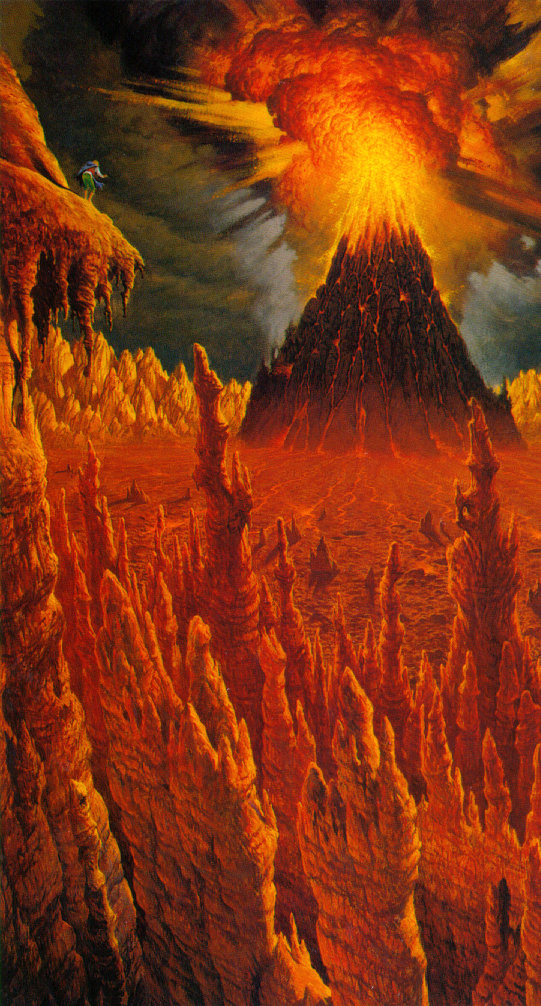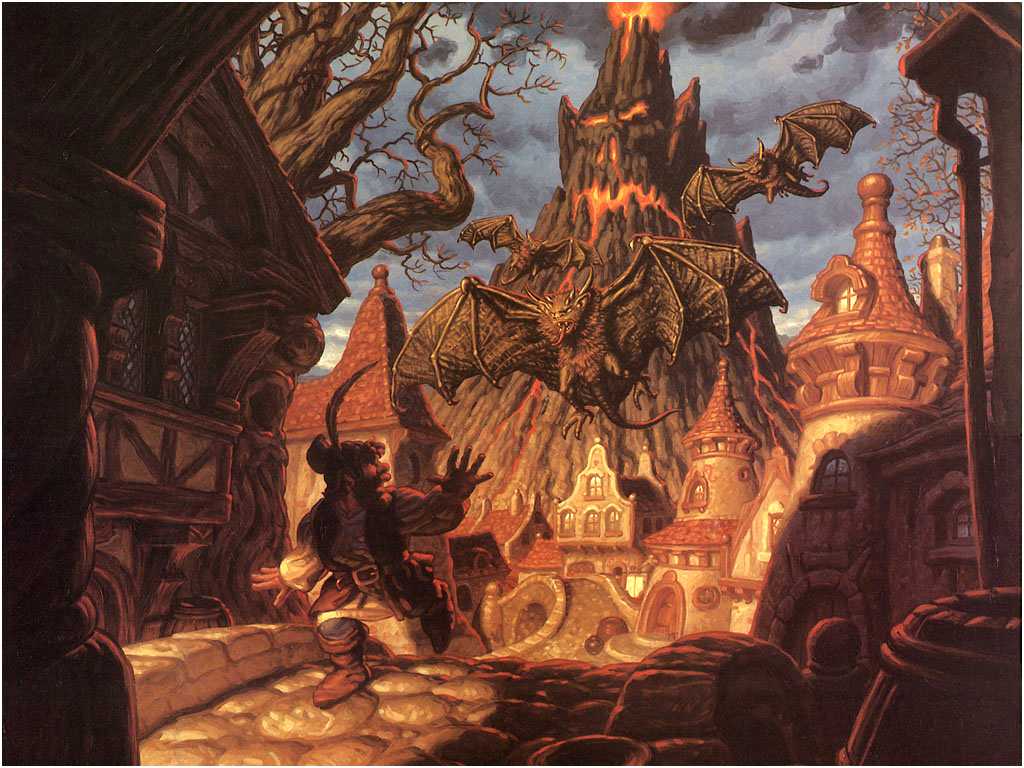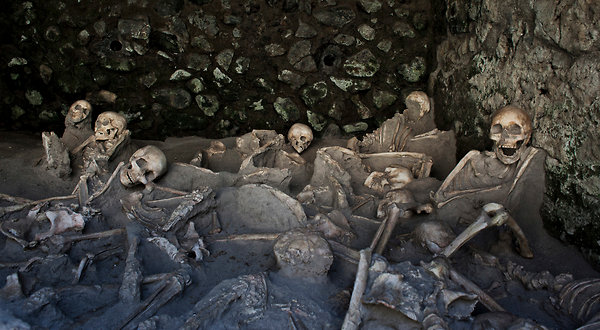VOLCANOES

VOLCANOES

|
|
|
|
|
|
|
|
|
|
|
|
|
|
|
|
|
|
Volcanic eruptions are
perhaps the most visually spectacular,
and certainly among the most dangerous,
of all the natural hazards that can occur
in the wilderness.
A volcano can lie dormant for such a long
time that it is all but forgotten about,
even in local lejends handed down from
those who survived the last eruption generations ago.
Then,
in the space of days or even hours,
it can come "alive" and mercilessly unleash
all the fury it has been storing up.
Other volcanoes are almost perpetually
active;
once every few weeks,
they spit out a bit of ash &&
smoke --
not enough to greatly affect the environment
or those who live nearby,
but enough to remind anyone within eyeshot
that someday it may do more than merely huff and puff.
Three types of volcanic
eruptions are described here for game
purposes. Any single volcano will always
erupt in only one of the
three types; a volcano will not spout
a lava eruption one time and
an ash eruption the next. Each type is
distinctly different, no only
in what the eruption produces but in the
effects it will have on anyone
or anything in the vicinity.

Volcanoes that exude
red-hot,
molten lava are colorful and
look quite threatening,
but actually have a relatively small potential
to harm characters
who are within sight range when it is erupting
-- unless, of course,
they stay in one spot and allow the
flowing lava to
touch them.
In an eruption, lava
is pushed up and out from a layer of molten
rock beneath the
mouth of the volcano. (The molten rock is properly
called magma when
it is inside the volcano, and lava after it is
expelled.) The red-hot
liquid can actually spray out of the center
of the crater, if
it is forced out by fairly high pressure from beneath
and if the molten
rock is relatively thick. Often the lava merely
“gurgles” up, out,
and down the sides of the volcano. The more
fluid the magma
beneath the surface, the less violent the explosion
that occurs when
it is propelled up to the surface. Sometimes,
some of the lava
will find its way out through fissures in the
sides of the volcano
if the mountain has such structural weaknesses.
This helps to dissipate
the force of the eruption out of the
mouth of the crater,
but does not eliminate the possibility; lava
can come out of
the top and sides of a volcano at the same time.
Lava can flow for
miles before it cools and hardens; the distance
it travels depends
upon the slope of the volcano and the
configuration of
the surrounding terrain. The liquid will incinerate
any combustible
objects it comes into contact with, even after it
has cooled so much
that it is barely still flowing. And even after it
has stopped flowing
and looks cooled, the lava will retain enough
heat for 2d3 weeks
thereafter to seriously burn any character or
creature who touches
it.
A character who is
capable of movement and in control of his
faculties can almost
certainly avoid coming into contact with flowing
lava if he is standing
even a short distance from the source of
the flow. The stuff
doesn’t move very rapidly - a speed of 250
yards per hour is
about average for a lava flow - and it doesn’t
usually come gushing
forth in massive quantities at one time.
A greater danger
to characters nearby comes from the expulsion
of pyroclastic material
- blobs of semi-hardened magma
and chunks of rock
that have been carried along in the upward
flow of the liquid.
These “bombs” and “blocks,” as they are
called, can be thrown
high and far by the force of the eruption,
and someone standing
in the wrong place at the wrong time
might be hit by
one or more of these sizzling chunks.
For a random determination
of what kind of lava eruption occurs,
the DM can roll
1d4 and refer to the indicated
result from this
list:
<added type and headings>
| d4 Roll | Type | Details |
| 1-2 | Type I
(Fluid Magma Volcano) |
The eruption is
fluid magma that will spew from the volcano for 2d6 days.
The lava comes out very slowly, but it is very hot. Any character closer than 500 yards to a significant source of flowing lava will take at least 1d6 points of damage per turn from radiant heat, and possibly much more than that if he is considerably closer than 500 yards. The effective temperature of the air 1/4 mile from the site of the eruption will increase by 50 degrees and remain at that temperature for as long as the eruption continues. Of course, the temperature increase will be much more than 50 degrees in close proximity to the site. The increase will taper off by 10 degrees per 1/4 mile of additional distance from the site, until no heat difference is detectable from 11/2 miles away. |
| 3 | Type II
(Thick Magma Volcano) |
The eruption is
thick magma that will spray out into the air
as well as flow out around the edges of the mouth of the volcano. The lava will continue coming out for 2d4 days, and during that time, any character closer than 500 yards to a sizable quantity of it will suffer at least 1d4 points of damage per turn. The effective temperature of the air 1/4 mile from the site of the eruption will increase by 30 degrees; this increase diminishes by 10 degrees for every 1/4 mile farther away, so that at 1 mile away no heat difference is felt. |
| 4 | Type III
(Thick Meteor Storm Volcano) |
The eruption is
thick magma plus pyroclastic material.
In addition to the effects described in the preceding paragraph, the bombs and blocks produced by this eruption can hurt or kill any character who is too close to the mouth of the volcano. There is a 1% chance per hour that a character within 1,000 yards of the site of the eruption will be hit by one or more chunks of pyroclastic material, causing him to lose 2d6 hit points of from burn damage and impact damage. For every 100 yards <(60 5squares)> of distance less than 1000 yards <(600 5squares)>, the chance of being hit increases by 5% per hour and the damage from a hit increases by 1d6. <theory: first d6 is impact, second d6 is heat. the distinction might be needed for the Burn rules, elsewhere in the WSG> |
<theory: youtube/vid
examples can be given for the 3 types of volcanoes, vid being preferable
to youtube>
<maybe re-arrange
the volcano types, in order of deadliness>
Quote:
Originally
Posted by fett527
Gary,
If you fall in lava, do you get a saving throw?

Yah,
right!
1
or less of 10d10 saves.
Gary
Quote:
Originally
Posted by Holy Bovine
If
Gary Gygax falls in lava the lava doesn't get a saving throw.
Everyone else just dies.

This
brings to mind the use of certain potent magical devices that would indeed
pretty much negate the effects of lava or magma--anything having to do
with compatibility with Elemental Fire.
Having
been divorced from my first wife, I no longer need such magical protection
Cheerio,
Gary

Volcanoes that have
ash eruptions can and often do expel
some lava at the
same time, but the molten rock
is overshadowed
-- quite literally
-- by huge clouds of thick, hot ash. Aside from
the initial “blast”
that begins the eruption, volcanoes of this sort
are seldom violent;
the danger they pose comes not from explosive
force or heat, but
from the enormous amount of ash, dust,
and minuscule lava
particles (all referred to hereafter as “ash”)
that they expel
and spread over the surrounding AREA.
An ash eruption usually
begins fairly abruptly, as a great portion
of the pent-up force
inside the volcano expends itself by
throwing a billowing
mass of ash into the air. The original cloud
can easily be 2,000
or 3,000 feet high directly above the mouth of
the volcano, and
so thick that one cannot see into it, much less
through it. The
lighter particles can be carried by the wind for
dozens of miles
before settling to the ground; even at that distance,
the accumulation
on solid surfaces can be as great as
three or four inches
over the course of an average-length eruption
of moderate intensity.
The ash blanket is much thicker, and
much heavier, in
areas closer to the eruption site where the
greater mass of
the material comes to earth.
The ash will choke
and kill any green plant life that receives
even a moderate
dusting. Ironically, though, the chemical composition
of volcanic ash
makes it one of nature’s best fertilizers:
Within as little
as a few months after an ash eruption, the slopes
of a volcano will
again be covered with plants that have thrived on
the rich soil that
killed their predecessors.
The eruption of Mount
St. Helens in the northwestern United
States during 1980
and 1981 (actually, there were six separate incidents
over a 10-month
period) was an ash eruption. In addition
to the damage done
by the ash and rock that was spewed from
the volcano’s mouth,
the eruption had other effects that demonstrate
how devastating
an ash eruption can be. The superheated
gas expelled from
the summit of the volcano melted the surrounding
snow cover, which
led to mudslides that covered more
than 100,000 acres
of land in the vicinity. The initial blast on May
18, 1980, had a
force equal to a 10-megaton hydrogen bomb; the
concussive force
knocked over trees as far as 4 miles away. During
the entire time
when the volcano remained active, the summit
of the mountain
was pulverized; the peak of Mount St. Helens
was 9,677 feet above
sea level before the eruption and only 8,364
feet when the last
expulsion of ash subsided.
In game terms, an
ash eruption will be one of three general
types; for a random
determination, the DM should
roll 1d6 and refer
to the following list:
| 1-3 | The eruption will
be light to moderate in intensity but of
extended duration; ash will be expelled for at least 12 hours each day for a period of 3-6 weeks (ld4+2). During the entire duration of the eruption, a significant amount of ash (at least 2 inches of total accumulation) will be carried 16-25 miles (ld10 + 15) away from the eruption site in the direction of the prevailing winds, and heavier amounts of ash (6 inches or more) will settle everywhere within a radius of 5-1 0 miles (1 d6 +4) of the site. A character within 2,000 yards of the eruption site will suffer ld3 points of burn damage per turn from the hot particles that settle on his body (unless, of course, he is in a shelter or otherwise protected). In addition, such a character must make a saving throw versus breath weapon once per turn to avoid going into a choking fit (-4 on attack rolls, +4 to be hit). A character who fails two saving throws in succession is in danger of being asphyxiated or suffocated; he will take ld4 points of damage per round, and will die unless he can receive aid within one turn. |
| 4-5 | The eruption will
be heavy in intensity but of relatively
short duration; ash will be expelled for 6-11 hours (1 d6 + 5) each day for a period of 1 d3 weeks. A significant amount of ash will accumulate 10-15 miles (ld6+9) away from the site in the direction of the wind, and a heavy accumulation (9 inches or more) will come down everywhere within a radius of 3-8 miles (ld6+2) from the site. The danger zone for characters is 4,000 yards, with effects as described above upon those who are unprotected and within that area. |
| 5-6 | The eruption will
be heavy (as described in the preceding
paragraph), and in addition the first 3-8 days of the eruption will be marked by the expulsion of pyroclastic material. See the last paragraph of the above section on lava eruptions for the possible effects on characters who are in the area of falling bombs and blocks. |

This type of eruption is impossible to
characterize in general
terms because it can take so many forms.
The one thing that all
explosive volcanoes have in common is
power. When the eruption
begins, the opening salvo can be strong
enough to literally
blow the top off the volcano. A volume
of several million cubic feet
of rock around the mouth of the crater
cracks and crumbles, and
the peak of the volcano collapses into
the chamber of magma or
ash (or both) that lies beneath the surface.
Any characters or creatures within sight
range of an explosive
eruption are in mortal danger from a variety
of sources. A huge
cloud of ash
&&
pyroclastic material will
spew forth and rain
down on the surrounding countryside. A
glowing avalanche of
thick lava && heavy ash will flow
out and down from the newly
enlarged mouth of the volcano, threatening
to incinerate and
then inundate anything within a radius
of 3-5 miles. Either the ash
cloud or the glowing avalanche, or both,
will exude superheated
air and noxious gases with the effect
of a double-strength
cloudkillspell: Breathing the air for
as little as one-half round will
slay anything with fewer than 8 + 1 HD.
Those with 8 + 1 to
10+1 HD
must save versus poison at -4, and those with
more than 10 + 1 HD
must save versus poison normally to
avoid death.
Fortunately, an explosive eruption gives
those in the AREA sufficient
warning before its fury is unleashed.
The volcano will puff
out small ash clouds, leak small amounts
of lava, and perhaps
send moderate tremors through the ground
for 1d3 days before
the eruption begins with full force. Anyone
who remains in the vicinity
despite these signals will get what he
deserves.